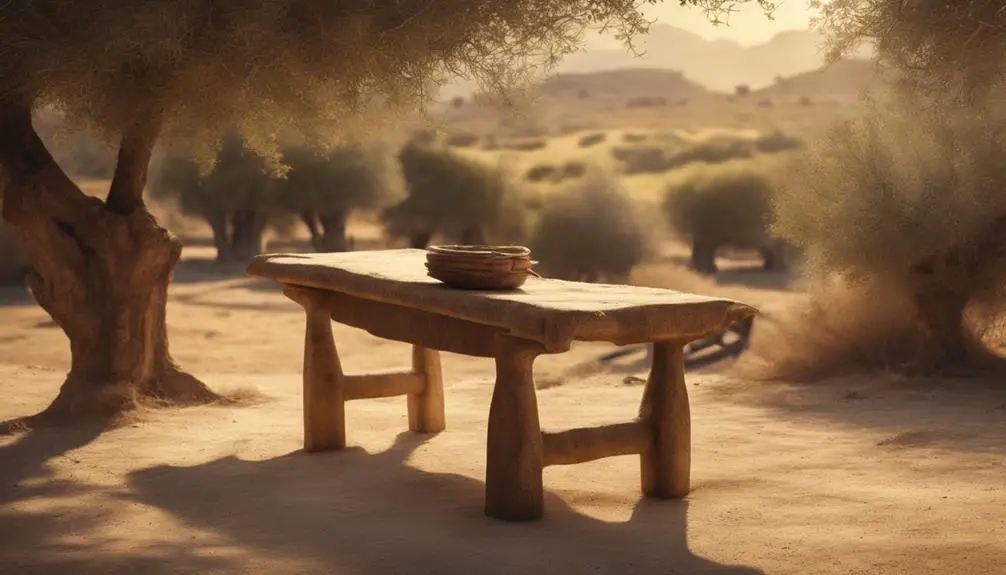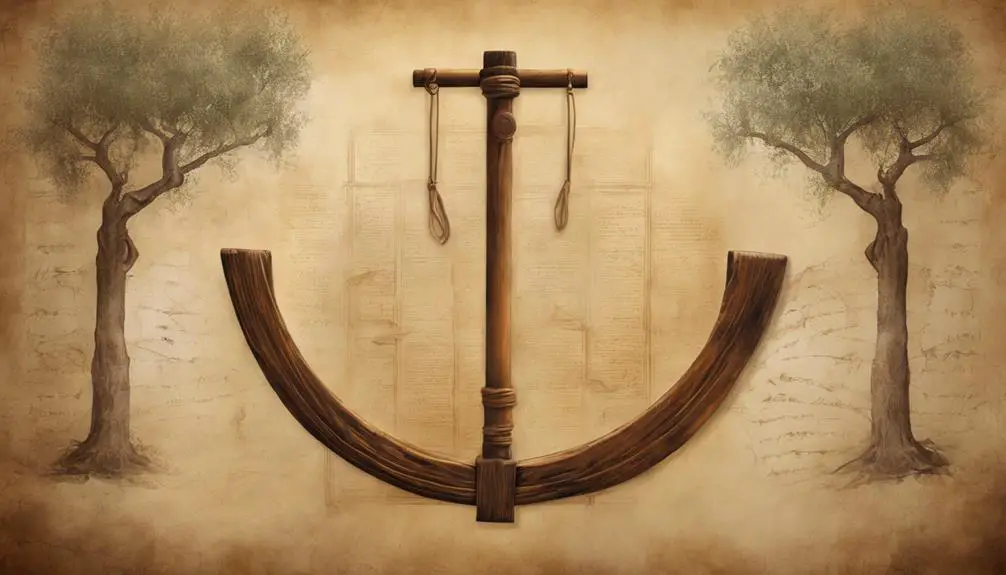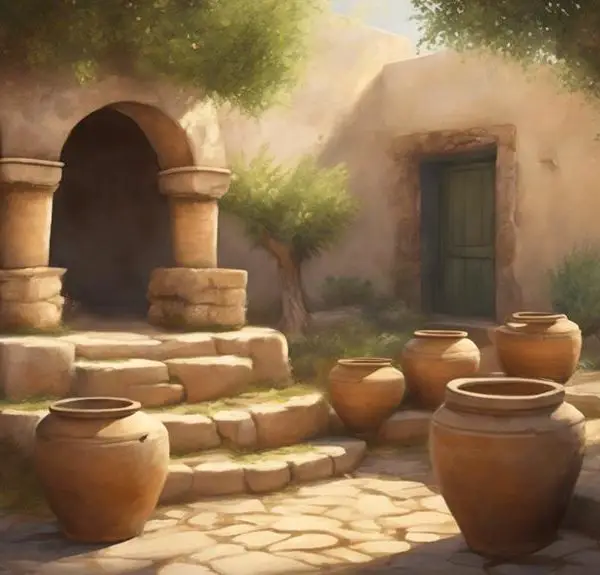Navigate the depths of the yoke's symbolism in the Bible, uncovering spiritual truths that bridge ancient wisdom with modern life's quests.

Picture of a Yoke in the Bible
The image of a yoke in the Bible serves as a bridge connecting ancient agricultural practices with profound spiritual truths. As you explore its historical significance, you'll uncover layers of symbolic meaning that have resonated through centuries.
From its role in prophetic literature to Jesus's teachings, the yoke embodies themes of burden, obedience, and liberation. Yet, the question remains: how does this ancient symbol speak to modern challenges and aspirations?
This inquiry invites you to consider the yoke not just as a relic of the past, but as a lens through which to view contemporary spiritual journeys.
Key Takeaways
- The yoke symbolizes both physical labor and spiritual burdens, reflecting themes of hardship and divine guidance.
- Jesus reinterprets the yoke as a metaphor for spiritual kinship, shifting its meaning from oppression to liberation.
- Scriptural references use the yoke to convey messages of repentance, hope, and redemption, emphasizing its dual role in warning and encouragement.
- The transformation of the yoke's symbolism highlights a journey from bondage to freedom, underscoring unity, liberation, and spiritual growth.
Historical Significance of the Yoke

Tracing its origins back to ancient civilizations, the yoke holds profound historical significance as a symbol of labor, control, and partnership in biblical contexts. Its primary function, facilitating the coupling of animals for the purpose of plowing and other agricultural uses, underscores the yoke's essential role in the development of early societies. You'll find that the crafting techniques employed in yoke manufacture were remarkably advanced for their time, reflecting a deep understanding of both the materials used and the anatomy of the animals they were intended for.
The design of the yoke evolved to maximize efficiency and minimize discomfort for the animals, a testament to the ingenuity and empathy of ancient peoples. This evolution in crafting techniques also mirrors the broader agricultural innovations of the era, which were instrumental in sustaining and expanding populations. The yoke, therefore, stands not just as a tool of labor but as a linchpin in the history of agricultural development.
In analyzing these aspects, you'll uncover the layers of significance that the yoke carries beyond its immediate practical applications. Its historical importance as a facilitator of agricultural progress and a reflection of human-animal relationships is unmistakable, illustrating the complexity and depth of this seemingly simple artifact.
Symbolic Meanings in Scripture
Having explored the yoke's historical importance, let's now examine its profound symbolic meanings within biblical scripture, where it serves as a multifaceted symbol of burden, discipline, and unity.
Yoke imagery, deeply ingrained in agricultural metaphors, offers a rich tapestry of interpretations that resonate across various passages. It's not just a tool for farming but a powerful symbol that conveys spiritual and moral lessons.
In scripture, a yoke often represents the weight of responsibilities or hardships, illustrating how burdens are borne in life's journey. This imagery encourages introspection about the nature of one's commitments and the strength derived from faith to carry them. It's a reminder that, though burdens may be heavy, they're not insurmountable with divine support.
The discipline aspect of the yoke is equally compelling. It symbolizes the need for guidance and the acceptance of divine will, teaching adherence to spiritual paths and the importance of yielding to higher wisdom for personal growth and enlightenment.
Lastly, the yoke's representation of unity is profound. It underscores the concept of shared burdens and collective endeavor, promoting a sense of companionship and mutual support within the faith community. This symbolism fosters an understanding of the importance of working together in harmony to achieve common spiritual goals.
Yoke in Prophetic Literature

In the realm of prophetic literature, the yoke emerges as a compelling symbol that elucidates the relationship between divine judgment and redemption. Prophets wield yoke metaphors with precision, weaving a rich tapestry of meaning that speaks volumes about the spiritual and socio-political conditions of their times.
- Yoke as Burden: Often, prophets depict the yoke as a burden laid upon the nations by God as a form of judgment for their iniquities. This imagery underscores the weight of sin and its consequences.
- Instrument of Oppression: In some texts, the yoke symbolizes the oppressive rule of foreign empires over Israel, highlighting the nation's subjugation and the loss of autonomy as a divine punishment.
- Call to Repentance: Prophetic imagery sometimes utilizes the yoke to call the people back to faithfulness. By casting off the yoke, they symbolically reject the sins that led to their downfall.
- Hope for Deliverance: Finally, prophets speak of breaking the yoke as a sign of God's future redemption. This act signifies liberation from bondage and the restoration of the covenant relationship.
Through the lens of prophetic literature, yoke metaphors serve as a multifaceted tool, conveying messages of warning, judgment, and ultimately, hope for deliverance.
Jesus's Teachings on the Yoke
Jesus's teachings significantly reframe the concept of the yoke, inviting his followers to understand it as a metaphor for spiritual kinship and liberation rather than a burden of legalistic observances. Through this lens, the yoke transcends its original agricultural context, embodying a divine invitation to a relationship grounded in grace and mutual support. This reimagining underscores a shift from the yoke as a symbol of subjugation to one of voluntary partnership in the pursuit of spiritual growth and communal well-being.
In analyzing Jesus's discourse on the yoke, it's paramount to consider its modern applications, especially in contexts of discipleship burdens. Contemporary believers are encouraged to interpret their commitments not as oppressive obligations, but as opportunities for deepening their spiritual connections and understanding of divine teachings. This perspective challenges followers to reevaluate the nature of their spiritual endeavors, recognizing that true discipleship involves embracing a yoke that, while demanding, is ultimately liberating and life-affirming.
Thus, Jesus's reinterpretation of the yoke invites a nuanced exploration of the balance between obligation and freedom in religious practice, offering a blueprint for a faith that's both deeply personal and expansively communal.
Liberation and the Yoke

Through the metaphor of the yoke, liberation emerges not just as a theological concept but as a tangible reality that redefines the nature of spiritual bondage and freedom. The Bible's use of yoke imagery and agricultural metaphors serves as a powerful tool in conveying this message. You'll find that the symbolism is rich and multifaceted, offering deep insights into the dynamics of liberation.
- Yoke imagery as a symbol of oppression: Initially, the yoke represents bondage and subjugation, a tool for harnessing animals for labor. In spiritual terms, it symbolizes the weight of sin and societal injustices.
- Agricultural metaphors for growth and freedom: Just as a yoke is used in farming to plow and prepare the earth, it metaphorically signifies the process of breaking free from the past and cultivating a new life.
- Transformation of the yoke's meaning: By reinterpreting the yoke as a symbol of mutual burden-bearing and discipleship, there's an invitation to a lighter, shared load.
- Liberation as a collective journey: The imagery encourages a community-oriented approach to freedom, emphasizing that liberation isn't just an individual endeavor but a collective movement towards spiritual emancipation.
This multifaceted approach to understanding the yoke in biblical texts underscores the complexity of liberation, blending physical and spiritual liberation into a coherent whole.
Frequently Asked Questions
How Do Modern Interpretations of the Yoke in the Bible Differ Among Various Christian Denominations?
You'll find that modern interpretations of the Bible's yoke symbolism vary widely among Christian denominations. Some see it as a metaphor for submission to divine authority, others as a call to community and mutual support.
Denominational perspectives play a significant role in shaping these views, with each interpreting the symbolism in ways that reflect their unique theological priorities and historical contexts. This diversity enriches the broader Christian understanding of biblical imagery.
Can the Concept of the Yoke Found in the Bible Be Paralleled With Any Similar Symbols in Other Major World Religions?
Absolutely, the concept of the yoke found in the Bible isn't stranded on an island of symbolism.
In exploring religious parallels, you'll find yoke symbolism threading through major world religions like an intricate tapestry.
Buddhism, for instance, uses the oxen yoke to symbolize attachment and burdens, mirroring Christian interpretations of bearing life's challenges.
This cross-religious motif highlights a universal human experience, deeply analyzed and revered across spiritual traditions.
How Have Artists Historically Depicted the Yoke in Biblical Scenes Across Different Periods and Styles?
You're diving into how artists have captured the yoke's symbolism in biblical scenes, spanning diverse periods and styles. They've employed various artistic mediums, from frescoes to oil paintings, to convey its deep metaphorical meanings.
Analyzing these depictions offers insights into the evolving interpretations of this symbol. Artists have skillfully woven the yoke's imagery to reflect themes of burden, guidance, or partnership, subtly shifting with the societal and theological currents of their times.
Are There Any Controversial or Widely Debated Interpretations of the Yoke in Biblical Scholarship?
Yes, interpretations of the yoke's symbolism in biblical texts have sparked debates among scholars, like a storm brewing over calm seas.
These discussions often delve into the historical context, analyzing how the yoke, a symbol of burden or partnership, shifts meaning across scriptures and time.
The scholarly debate is rich, dissecting layers of metaphor and allegory, revealing the complexity of biblical imagery and its profound impact on theological understanding.
How Is the Metaphor of the Yoke Used in Contemporary Christian Ministry and Counseling Practices?
In contemporary Christian ministry and counseling, the metaphor of the yoke is often used to discuss leadership burden and spiritual freedom.
You'll find it's applied to illustrate how leaders can share burdens, promoting a sense of community and support.
Additionally, it's utilized to encourage individuals to cast their burdens onto Christ for spiritual freedom, emphasizing liberation from personal struggles and societal pressures.
This approach fosters a deeper understanding of shared responsibility and personal relief.
Conclusion
As you've journeyed through the labyrinth of meanings that the yoke embodies within biblical narratives, it's clear that this symbol isn't merely a wooden harness but a vessel carrying profound spiritual and liberational messages.
Like a beacon guiding ships through treacherous waters, the biblical yoke illuminates paths of obedience, burden-sharing, and ultimate freedom. Analyzing its presence across scriptures, we uncover layers of divine wisdom, teaching us that in embracing our yokes, we're invited into a dance of liberation with the Divine.



Sign up